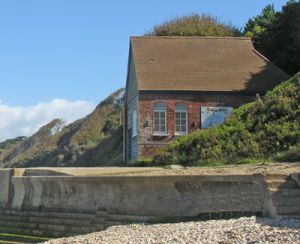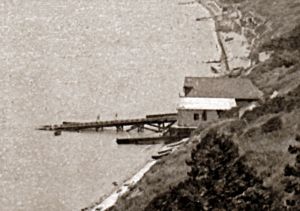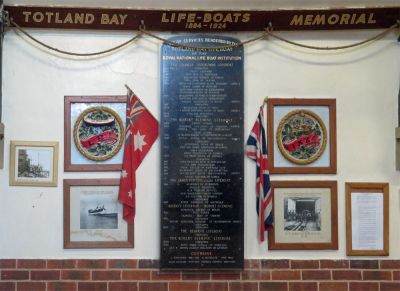Totland Lifeboat
A 28ft, Lamb and White lifeboat, 'the Dove', built in 1868 and provided by the Isle of Wight Sunday School Lifeboat Fund was put on station in 1870.
In 1883, the RNLI had decided to open a station at Totland and a boathouse with a slipway was constructed. In 1885, the 'Charles Luckombe' was the first RNLI lifeboat put on station and the 'Dove' was transferred to Shanklin.
The 'Charles Luckombe' was built by Messrs. Forrestt and Son, of Limehouse, London. She was 37 feet long, 8 feet in beam, self-righting and self-ejecting water, with twelve rowing oars, double-banked. The cost was met by a bequest from Mrs. Luckombe, of Brighton.[1]
In 1903 a new lifeboat, the 'Robert Fleming', was put on station at Totland, she had been funded by a £1000 bequest to the Royal National Lifeboat Institution from the estate of Mrs. Mary Fleming, formerly of Regent’s Park, for providing a lifeboat on the coast of Hampshire in memory of her late husband, Robert Fleming. The 'Robert Fleming' lifeboat was a self-righting type of 38ft in length and could be sailed or rowed. [2]
In 1915 the steam lifeboat 'James Stevens III' replaced the 'Robert Fleming' at Totland. In 1894 the RNLI had received £50,000 from the estate of Mr James Stevens of Birmingham, this was/is one of their largest legacies (today, 2016, it equates to over £6 million.) This legacy helped fund 20 RNLI lifeboats[3].
In 1919 the ‘James Stevens III’ was removed and, after taking part in a ‘great river procession’ on the Thames she was stationed at Dover. The ‘Robert Fleming’ then returned to serve Totland ‘pending the motor-lifeboat which is being built for Totland Bay’.[4]
However, a motor-lifeboat never arrived at Totland and the station closed in 1924 when a motor lifeboat was stationed at Yarmouth, the sheltered waters of Yarmouth Harbour being considered more suitable than the exposed Totland Bay station.
The Totland RNLI lifeboat Service Board forms part of the RNLI memorial in the Totland Parish Hall, the flag to the left of the board is the Australian Red Ensign as used by the Australian merchant navy from 1901 (why it's there, is a good question).
The front part of the original RNLI lifeboat house and the ramp were removed during the 1960's when the sea defences were rebuilt and a slipway was built into the seawall at the same time.
There are some suggestions elsewhere that the original RNLI lifeboat house was demolished in 1924 and that the remaining building is H. Simmonds' boat house which was adjacent to the lifeboat house. Evidence at the scene and local knowledge indicates that the surviving building is indeed the remains of the RNLI lifeboat house and that it was the H. Simmonds's building which was demolished.
- ↑ Hampshire Advertiser - 21 March 1885
- ↑ Isle of Wight County Press - 22 August 1903
- ↑ https://rnli.org/magazine/magazine-featured-list/2019/september/who-was-james-stevens
- ↑ Isle of Wight County Press - 26 July 1919


